

Plain packaging for tobacco products has slowly been rolled out across the world, with Australia pioneering the legislation at the start of the decade (Tobacco Plain Packaging Act 2011), and New Zealand, France, the UK, and Ireland, among others, steadily implementing measures across the last five years.
Ever since the idea was first introduced the question has been raised whether this uniform packaging approach could be introduced within different packaging sectors; specifically those where there is a deemed health risk to the individual, such as for alcohol products.
In the UK plain tobacco packaging standards came into effect in May 2016 (with all tobacco products being required to use the new standardised packaging by May 2017) and speaking to Fairfax Media, a lawyer for British American Tobacco referred to tobacco as the “canary in the coal mine” claiming that the industry is usually the progenitor of legislative restrictions being implemented across other sectors.
Changing drinking behaviour
Public Health England, in their recent Public Health Burden of Alcohol and the Effectiveness and Cost-Effectiveness of Alcohol Control Policies evidence review identified that labelling within the alcoholic drinks is not currently up to scratch, stating that “there is a general consensus among experts that alcohol labels have been poorly implemented and this may, in part, explain the finding that labels are ineffective in changing drinking behaviour.”
However controversy spanned from the recommendations as how such behaviour could be improved, with plain packaging being offered as one considered solution. This suggestion has sparked fear in drinks manufacturers, who currently do not have to adhere to any mandatory labelling requirements, only voluntary alcohol guideline measures and pregnancy warnings.
As plain packaging is currently only a proposed measure, there is little evidence either way to suggest whether or not it would change people’s drinking habits. If you consider the tobacco industry however, and take queues from the effect it has had on Australian smokers, there is certainly potential for behavioural change.
An independent review carried out in Victoria, Australia and published in the British Medical Journal concluded that smokers considered cigarettes in plain packaging to be lower quality than in branded packs; found the cigarettes less satisfying; and crucially, were more likely to have thought about quitting at least once a day, placing quitting smoking at a higher priority than they did previously. Though while alcohol consumption can undeniably lead to health defects, it is worth noting however that there are fundamental differences between drinking alcoholic beverages and smoking cigarettes, so using identical packaging restrictions would likely lead to differing results.
At what cost?
The damage uniform packaging or labelling would have on certain subsectors within the alcoholic drinks sector is also worth considering. Craft drinks make up a huge proportion of the alcohol market, with hundreds of new products being launched every year. “It will crush the craft side of the industry” said Jared Brown, founder of distillery Sipsmith speaking to the Guardian, “It will shift the business back to the industrial producers…If something like this comes through we won’t be able to weather it.”
The government in the UK will then have to weigh the effect such measures will have upon the industry, but given how many small business will be impacted, with many, even potentially the majority, being wiped out all together, it seems likely that plain packaging, within this sector at least, is unlikely to be the answer.



